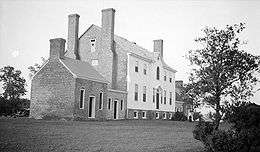Gustavus Richard Brown
Gustavus Richard Brown (October 17, 1747[1][2] – September 30, 1804[3][4]) was a lifelong friend of George Washington, a physician, helped found the hospital department of the Continental Army, and a botanist.[5] He is best known as one of the doctors summoned to attend to George Washington the night he died.[6][7][8]

Gustavus Brown studied medicine in Edinburgh, Scotland, graduating in 1768. In addition to medicine, he was elected to the legislature of Maryland, and served as a judge. He was a member of the Maryland state convention of 1788 and voted to ratify the U. S. Constitution.[9][10] During the American Revolution, he helped establish the hospital department and was surgeon-general of the Continental Army. He was called on by General Washington to inspect the Maryland troops and enroll the names of the able-bodied men.[11]
Around 1780, he bought and combined four tracts of land from his neighbor, now known as "Betty's Delight".[8] Combining this land with his own, he built and in about 1783 moved into Rose Hill, his manor house[12][13] Rose Hill is adjacent to the Thomas Stone National Historic Site.
Along with Dr. James Craik, "Dr. Gustavus R. Brown, another prominent resident of Port Tobacco, and Dr. Elisha Cullen Dick, attended [George] Washington during his final illness, December 14, 1799. Dr. James Craik was so impressed with Dr. Brown's medical skills that he suggested to Mrs. Washington (Martha), that if any case should occur that was seriously alarming, she should send for Dr. Brown."[14]
The Dr. Gustavus Brown Elementary in Waldorf, Maryland is named after him. His younger sister, Margaret, married Thomas Stone, a signatory of the Declaration of Independence.
In some records Dr. Brown is confused with his father of the same name, who came from Dalkeith, Scotland in 1708.[15] The elder Gustavus Brown settled at Middleton (named after his family homestead near Dalkeith, Scotland) in Charles County, Maryland, as related by his descendant Moncure Daniel Conway.[16]
Notes
- ↑ "Gustavus Brown". Retrieved 2008-12-06.
- ↑ "Gustavus Richard Brown / Peggy Graham". Archived from the original on June 30, 2009. Retrieved 2008-12-06.
- ↑ Ridgely pp 63-64
- ↑ "Gustavus Brown Burial Site, Charles County, Maryland". Interment.net. Retrieved 2007-11-29.
- ↑ Jean Butenhoff Lee (1994). "The Price of Nationhood: The American Revolution in Charles County". W. W. Norton & Company: 4. ISBN 0-393-03658-8.
- ↑ Wilstach, pp 102-104
- ↑ "George Washington Really Did Sleep Here". Maryland Office of Tourism. Retrieved 2007-10-01.
- 1 2 Arnett, pp 44-45
- ↑ Scharf, pp 749
- ↑ "Maryland Manual, 1926". 137. Maryland State Archives: 320.
- ↑ Edward Huntington Merrell, D. D. (1906). "John Scott Horner: A Biographical Sketch". Madison, Wisconsin: State Historical Society of Wisconsin. Proceedings of the State Historical Society of Wisconsin at its Fifty-third Annual Meeting Held November 9, 1905
- ↑ Sometime after the 1783 tax assessment, according to the Maryland Historical Trust web page.
- ↑ "Rose Hill". The Historical Marker Database. June 17, 2007. Retrieved 2008-11-01.
- ↑ George Washington Masonic National Memorial, John P. Riddell, Curator, Replica Lodge Room
- ↑ "Who was Dr. Gustavus Brown?". Charles County Board of Education. Retrieved 2007-10-05.
- ↑ Conway, pp 1-5.
References
- Arnett, Earl; Dr. Robert J Brugger; Edward C. Papenfuse (1999). Maryland: A New Guide to the Old Line State. Johns Hopkins University Press. ISBN 978-0-8018-5980-9.
- Conway, Moncure Daniel (1904). Autobiography Memories and Experiences of Moncure Daniel Conway. 1. Houghton, Mifflin & Co. ISBN 0-8371-1813-1.
- Ridgely, Helen West (1908). Historic Graves of Maryland and the District of Columbia. The Grafton press. ISBN 1-103-73706-6.
- Scharf, John Thomas (1879). History of Maryland from the Earliest Period to the Present Day. John B. Piet.